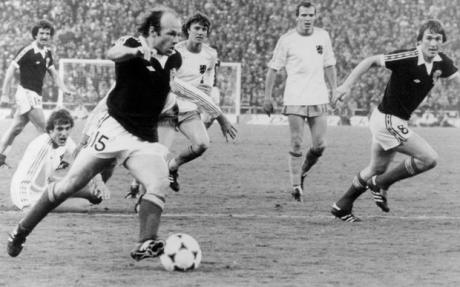
While their close neighbors and erstwhile enemies in Ireland, Scotland and Wales crow this morning over another anguished English exit from the World Cup, great swaths of the globe suffer alongside the Albion faithful. Some of this is due to the sheer size of the cultural footprint left by the mother country, once an Empire, today a Commonwealth. Yet millions more in places that have shaken off even that lighter cohesion (Hong Kong, Singapore, Mumbai, Capetown) still follow the English game because the English introduced it to them a century ago. Billions more pay special attention for reasons better explained by 21st century marketing: Across Asia, the Middle East and the United States, 25 years of English Premier League broadcasts have bred spectacular ratings and merchandize sales, ephemeral things that have ultimately morphed into a form of allegiance — a fandom all the better fed by internet access to the always entertaining, bandwagon-inclined British football media.
For 30 minutes in Moscow on Wednesday, the English would appear to have produced — for the first time in 54 years — a team equal to this global glut of hope and expectation.
To the delight of Gaels everywhere, it was instead Croatia that earned a place in Sunday’s World Cup final against France, claiming a dogged 2-1 victory in extra time. This had been another pillar of English support Wednesday — the prospect of a cross-Channel, once-more-into-the-breech final, a rematch some 1,054 years in the making! But the indefatigable Croats were deserving winners. They adjusted and persevered where England could not.
The opening half hour would appear to have signaled the next in a series of sanguine developments for the English at this World Cup. A weak group had led to a preposterously easy side of the tournament draw. A great escape vs. Colombia in the Round of 16 (on penalties of all things) was followed by a thorough bludgeoning of Sweden (a team England had beaten just twice in 16 tries). In Wednesday’s semifinal, Kieran Trippier’s splendid free kick put England ahead 1-0 after just 7 minutes. The ensuing 20 minutes saw Raheem Sterling, the sprightly Man City striker, run rings around the Croatian defense.
This was the key to the game: England found it so easy to get Sterling in behind Croatian centerbacks Dejan Lovren and Domagoj Vida, another goal seemed just a matter of time. Harry Kane indeed should have made it 2-0 after 15 minutes, having found himself on the doorstep with the option to shoot or slide it to Sterling for a tap-in. He went for goal, had it saved, then clanged the rebound off keeper Danijel Subasic and the post. That ball goes in and there’s no way back for the Croatians, though it seemed of little consequence at the time. The English were that good, that confident on the ball, that in control of this match.
That dominance, in a roundabout way, proved England’s undoing. Instead of continuing to patiently knock the ball around and pick the Croats apart (a side running on fumes after playing two exhausting knockout games in the previous 7 days), England were beguiled by Sterling’s ability to get in behind Lovren and Vida. The last 15 minutes of the half were squandered, as the English eschewed possession and impulsively pumped long balls over the top.
Pundits have claimed that England played an excellent half on Wednesday. They did not. They played an excellent half hour, then muddled their way to the break with a lead only half (or a third) of what it should have been.
Croatia made one vital adjustment before intermission, dropping Lovren and Vida off Kane (and his withdrawn running mate Dele Alli), in order to better cope with the speedy threat of Sterling. After halftime, they changed things up again — pressing England higher up the pitch. All of a sudden, central midfielder Jordan Henderson had no time on the ball. After 45 minutes of expert English distribution out of the back, Croatia took this away.
England made no adjustment at halftime and much as it tried, could not make one on the fly. The long balls continued, with ever diminishing returns. Faced with this increased pressure, Henderson and the entire English defense were a study in creeping panic — launching hopeful balls forward rather than risk having it taken by the Croats who, the longer this game went (despite their travails), looked the more energetic side. In the first 30 minutes Henderson & Co. looked imperious. After 60, they no longer wanted the ball at their feet. At this level, that is a recipe for just one thing: hanging on for dear life.
All of this ignores fully half the match, which would indeed require 120 minutes to decide. Ivan Perisic (I’ll not be bothering here with all the various Croatian accent marks, you’ll notice) leveled things on 70 minutes and England’s descent into anxiety and fatigue only got steeper. They were lucky to make it to extra time, when Mario Mandzukic struck the winner some 7 minutes before the onset of penalty kicks. England made the maximum four substitutions over the last hour, desperately looking to change the game, to change its own footing in and approach to the match. Nothing worked. Trippier injured his groin after the Mandzukic goal; having exhausted their allotment of subs, England finished meekly, playing 10 v. 11.
In the end, the Croats proved more canny, more flexible, more skilled, more confident, more dogged, more fit. They were deserving winners.



